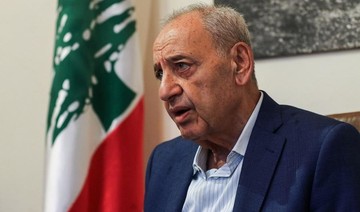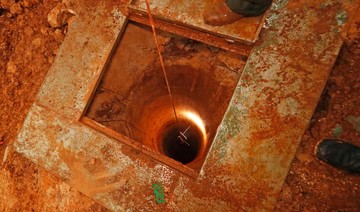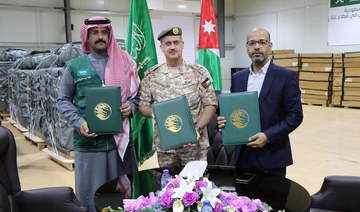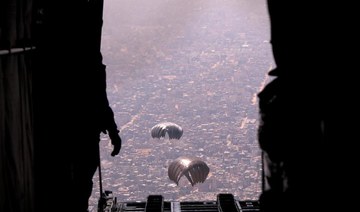BEIRUT: Syrian refugees in Lebanon are falling deeper into debt, with 2018 being the worst year yet, as more families marry off children to cope financially, according to a report by the United Nations released on Wednesday.
The study by the UN refugee agency (UNHCR), the World Food Programme (WFP) and the UN children’s fund (UNICEF) stated that the average household debt has increased in the last three years from $800 in 2016 to more than $1,000 in 2018.
The Syrian conflict that erupted in 2011 has generated 5.6 million refugees in the Middle East, with Lebanon hosting more than 950,000 registered refugees, according to UNHCR.
With families struggling to afford food, rent and medicine, child marriage is also on the rise.
Twenty-nine percent of Syrian girls aged between 15 and 19 are married in Lebanon, a number that has been growing, according to the report.
“These findings are a reminder to all of us that the situation for children is becoming more delicate,” said Tanya Chapuizat, UNICEF Representative.
“We are seeing refugee families resorting to behaviors that put their children at increasing harmful risks,” she stated in the report.
Around 69 percent of Syrian refugee families in Lebanon are living below the poverty line and nearly eight out of 10 Syrian kids aged 3 to 5 and 15 to 17 are not in school.
Many children are forced to work, cannot afford transportation or lack the supplies they need to go to school.
The proportion of Syrian child refugees working in Lebanon has risen to 7 percent from 4 percent in late 2016, according to research by the Danish Refugee Council (DRC).
Shelter conditions have also worsened among Syrian households, and 34 percent now live in non-residential or non-permanent structures, an increase from 26 percent in 2017 according to the report.
“The study is a poignant reminder of the daily hurdles refugees have to go through just in order to survive,” UNHCR Representative in Lebanon Mireille Girard said in the report.
Struggling to survive, Syrian refugees in Lebanon fall deeper into debt
Struggling to survive, Syrian refugees in Lebanon fall deeper into debt

- The Syrian conflict that erupted in 2011 has generated 5.6 million refugees in the Middle East
- Around 69 percent of Syrian refugee families in Lebanon are living below the poverty line
Once fruitful, Libyan village suffers climate crisis

KABAW, Libya: In the Libyan village of Kabaw in the Nafusa Mountains, M’hamed Maakaf waters an ailing fig tree as climate change pushes villagers to forsake lands and livestock.
Once flourishing and known for its figs, olives, and almonds, fields around Kabaw, located some 200 kilometers (124 miles) southwest of Tripoli, are now mostly barren and battered by climate change-induced drought.
The area was once “green and prosperous until the beginning of the millennium,” Maakaf recalled. “People loved to come here and take walks but today it has become so dry that it’s unbearable.”
“We no longer see the green meadows we knew in the 1960s and ‘70s,” added the 65-year-old, wearing a traditional white tunic and sirwal trousers.
Kabaw, like many villages in the Nafusa Mountains, is primarily inhabited by Amazigh people, a non-Arab minority.

Pounded by the sun and dry winds, the mountainous area now struggles to bear fruit, facing a lack of rainfall and temperatures high above seasonal norms.
Libya — where around 95 percent of land is desert — is one of the world’s most water-scarce countries, according to the United Nations.
Its annual precipitation in coastal areas has fallen from 400 millimeters in 2019 to 200 millimeters today, with water demand higher than what is available.
The Nafusa Mountains, sitting at an altitude of almost 1,000 meters (3,280 feet) in western Libya, are home to around half a million people out of Libya’s population of seven million.
Driven out by increasing water stress, local villagers and their livestock have been gradually moving out of the Nafusa Mountains and surrounding plains.
‘How can we be patient?’
Mourad Makhlouf, mayor of Kabaw, says that drought in the last decade has pushed hundreds of families to leave for the capital Tripoli and other coastal cities, where water is easier to access.
“It’s not just about water scarcity or crops dying due to drought,” said Makhlouf. “There is a demographic and human dimension with the exodus of hundreds of families toward the capital and coastal towns.”

Suleiman Mohammed, a local farmer, fears that climate change will soon cause everyone to leave, as “living without water is certain death.”
“How can we be patient?” he said. “It has gotten to the point where breeders sell their livestock because keeping them costs twice their value.”
Standing by a cluster of dead tree trunks, Maakaf decries the loss of “thousands of olive trees.”
“Some were 200 years old and inherited from our grandfathers,” he said.
Hoping to alleviate the burden, local authorities began selling subsidized water for 25 Libyan dinars (about $5) per 12,000 liters.
Tanker trucks make the trip between the water stations and the village, traveling up to 50 kilometers and allowing some of those in need to hold on.
“We manage to water our fields two to three times a week but water is expensive,” Maakaf said, adding that they also rely on private tanker trucks selling the same amount for up to 160 dinars.
Relief plan needed
The hydrocarbon-rich country hosts the world’s largest irrigation project, the Great Man-Made River, its main source of water supply built in the 1980s under the rule of longtime dictator Muammar Qaddafi.
Drawing fossil water from aquifers in the heart of the southern desert, the network of pipes supplies about 60 percent of the national need.
But the supplies remain insufficient amid increasing drought.

According to the World Resources Institute, an environmental research organization, Libya will face “extremely high” water stress by 2050.
The World Bank predicts that by 2030, the Middle East and North Africa region will fall below the “absolute water scarcity” threshold.
“Water scarcity is one of the greatest emerging threats facing Libya,” the UN Development Programme said in a study.
“The country needs to ensure equitable access to water for domestic and economic purposes.”
“Climate smart agricultural methods should reduce the overuse of water resources and... practices that contribute to soil erosion and desertification, which further impact productive sectors and food security.”
Libya signed the 2015 United Nations framework convention on climate change and ratified the Paris Climate Accord in 2021.
Yet the North African country has shown little progress toward the development of disaster risk reduction and climate adaptation strategies, as it continues to grapple with divisions and conflict after the fall of Qaddafi in 2011.
“The drought does not only concern the Nafusa Mountains, but the entire country,” said Mayor Makhlouf.
“Libya needs a relief plan, which will not be the solution to everything, but will allow us to adapt.”
Biden adviser will be in Israel on Monday to avoid escalation between Israel, Lebanon

WASHINGTON: A senior Biden adviser will travel to Israel on Monday for meetings to avoid further escalation between Israel and Lebanon, a White House official said.
Amos Hochstein will advance efforts to avoid further escalation along the “Blue Line” between Israel and Lebanon, said the official, who did not wish to be identified.
Attacks between Israel and Iran-backed Hezbollah militants in Lebanon have led to worries of a deeper war across the Middle East.
Israel warns of escalation from cross-border fire from Hezbollah

- Hezbollah says it will not halt fire unless Israel stops its military offensive on Gaza
JERUSALEM: Intensified cross-border fire from Lebanon’s Hezbollah movement into Israel could trigger serious escalation, the Israeli military said on Sunday.
“Hezbollah’s increasing aggression is bringing us to the brink of what could be a wider escalation, one that could have devastating consequences for Lebanon and the entire region,” Israeli military spokesperson Rear Admiral Daniel Hagari said in a video statement in English.
Iran-backed Hezbollah last week launched the largest volleys of rockets and drones yet in the eight months it has been exchanging fire with the Israeli military, in parallel with the Gaza war.
After the relatively heavy exchanges over the past week, Sunday saw a marked drop in Hezbollah fire, while the Israeli military said that it had carried out several air strikes against the group in southern Lebanon.
The US and France are working on a negotiated settlement to the hostilities along Lebanon’s southern border. Hezbollah says it will not halt fire unless Israel stops its military offensive on Gaza.
“Israel will take the necessary measures to protect its civilians — until security along our border with Lebanon is restored,” Hagari said.
‘No joy’: Gazans mark somber Eid in shadow of war

- Many Palestinians forced to spend holiday without their loved ones
- I hope the world will put pressure to end the war on us because we are truly dying, and our children are broken
GAZA STRIP: In tents in the stifling heat and bombed-out mosques, Gazans on Sunday marked the start of the Eid Al-Adha holiday, devoid of the usual cheer as the Israel-Hamas war raged on.
“There is no joy. We have been robbed of it,” said Malakiya Salman, a 57-year-old displaced woman now living in a tent in Khan Younis City in the southern Gaza Strip.
Gazans, like Muslims the world over, would usually slaughter sheep for the holiday — whose Arabic name means “feast of the sacrifice” — and share the meat with the needy.
Parents would also give their children new clothes and money for the celebration.
But this year, after more than eight months of a devastating Israeli campaign that has flattened much of Gaza, displaced most of the besieged territory’s 2.4 million people, and sparked repeated warnings of famine, the Eid is a day of misery for many.
“I hope the world will put pressure to end the war on us because we are truly dying, and our children are broken,” said Salman.
Her family was displaced from the far-southern city of Rafah, a recent focus of the fighting which began after Hamas’s Oct. 7 attack on southern Israel.
The military on Sunday morning announced a “tactical pause of military activity” around a Rafah-area route to facilitate the delivery of desperately needed humanitarian aid to Gazans.
AFP correspondents said there were no reports of strikes or shelling since dawn, though the Israeli military stressed there was “no cessation of hostilities in the southern Gaza Strip.”
The brief respite in fighting allowed worshippers a rare moment of calm on holiday.
Many gathered for the Eid Al-Adha morning prayer in the courtyard of Gaza City’s historic Omari Mosque, which was heavily damaged in Israeli bombardment, placing down their frayed prayer mats next to mounds of rubble.
The sound of prayers traveled down some of the city’s destroyed and abandoned streets.
“Since this morning, we’ve felt a sudden calm with no gunfire or bombings ... It’s strange,” said 30-year-old Haitham Al-Ghura from Gaza City.
He hoped the pause meant a permanent ceasefire was near, though truce mediation efforts have stalled for months.
In several areas of the war-battered territory, especially in Gaza City, young boys were seen manning roadside shops selling perfumes, lotions, and other items against the backdrop of piles of rubble from destroyed buildings and homes.
Many vendors used umbrellas to protect themselves from the scorching sun as they sold household items on Gaza City’s main market street. But there were few buyers.
Food and other goods can reach four or five times their usual price, but those who cling to the holiday traditions can still afford them.
In Khan Younis, displaced man Majdi Abdul Raouf spent 4,500 shekels ($1,200) — a small fortune for most Gazans — on a sheep to sacrifice.
“I was determined to buy it despite the high prices, to perform these rituals and bring some joy and happiness to the children in the displacement camp,” said the 60-year-old, who fled his home in Rafah.
“There is sadness, severe pain, and suffering, but I insisted on having a different kind of day.”
The deadliest-ever Gaza war began after Hamas’s unprecedented Oct. 7 attack.
Israel’s retaliatory offensive has killed at least 37,337 people in Gaza, also mostly civilians, according to the Health Ministry in the territory.
For many, a halt in fighting can never bring back what has been lost.
“We’ve lost many people, there’s a lot of destruction,” said Umm Mohammed Al-Katri from Jabalia refugee camp in northern Gaza.
“This Eid is completely different,” she said, with many Gazans forced to spend the holiday without their loved ones killed or displaced during the war.
Grieving families on Sunday flocked to cemeteries and other makeshift burial sites, where wooden planks marked the graves.
“I feel comfort here,” said Khalil Diab Essbiah at the cemetery where his two children are buried.
Even with the constant buzzing of Israeli drones overhead, visitors at the cemetery “can feel relieved of the genocide we are in and the death and destruction,” he said.
Hanaa Abu Jazar, 11, also displaced from Rafah to the tent city in Khan Yunis, said: “We see the (Israeli) occupation killing children, women and the elderly.”
“How can we celebrate?” asked the girl.
Jordan conducts three airdrops in southern Gaza

- Aid packages containing food, clothing, and sweets were delivered to various locations in the southern Gaza
AMMAN: Jordan’s armed forces conducted three airdrops to the southern part of Gaza on Sunday, in collaboration with Egypt, to mark the first day of Eid Al-Adha, Jordan News Agency reported.
Aid packages containing food, clothing, and sweets were delivered to various locations in the southern Gaza Strip by two planes from the Royal Jordanian Air Force and an aircraft from Egypt.
Earlier on Saturday, a 45-truck humanitarian aid convoy arrived in Gaza, sent by the JAF and the Jordan Hashemite Charity Organization (JHCO).
In cooperation with its regional and international allies, the Jordanian armed forces have carried out 261 airdrops and delivered 1,970 trucks of aid since the beginning of Israel’s onslaught on Gaza.
WHO chief Tedros Adhanom Ghebreyesus said that “a significant proportion of Gaza’s population is now facing catastrophic hunger and famine-like conditions,” as Israel continues to impose severe restrictions on the supply of food, water, medicine, and fuel to the Strip.



















